August 2018
Honoring Yesterday – Protecting Tomorrow
Vol. 49, No. 8
What’s Inside
- President’s Message
- August General Membership Meeting
- What’s An Investment Fiduciary?
- SDCCU Save for Long-Term Care Seminar
- Pension Facts
- Share Your Experiences
- 2018 Coming Home Event
- Bits and Pieces
- Recent Events
- BOS Recognizes Scholarship Recipients
- Susan Mallett Elected to Senior Legislature
- North County RESDC Roundup
- 2019 SDCERA Health Plan Rates
- Do a Senior’s Nutritional Needs Change?
- Welcome New Members
August Calendar of Events
Thurs., August 9, 9:30am
RESDC Board of Directors Retreat
8825 Aero Drive, Suite 205
Thurs., August 16, 9:00am
SDCERA Board of Retirement Meeting
2275 Rio Bonito Way, Suite 200
Weds., August 22, 9:30am
RESDC General Membership Meeting
St. Paul’s Senior Services, St. Paul’s Plaza
1420 E. Palomar St., Chula Vista, 91913
![]() View the NETWORK
View the NETWORK
as a printable PDF
Are you on social media?
Stay connected with us!
![]()
![]()
![]()
Quote of the Month
“At the end of the day, the most overwhelming key to a child’s success is the positive involvement of parents.”
▪ Jane D. Hull
President’s Message
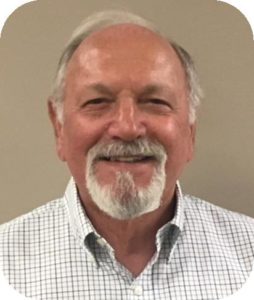
By John J. McTighe
They had fifteen minutes to pack up whatever they could and get out of there. The winds were swirling, and the fire was burning down houses like matchsticks. The only ones home were my wife’s 17-year old cousin and her 93-year old great grandpa. What should they take? They ended up taking medicines for the whole family, the cat, and a change of clothes. Fortunately, some local good Samaritans were helping to rescue neighborhood dogs, so they were taken away safely. That was the scene last month in Alpine when the West Fire was burning out of control.
I often wonder how I would react if my house was threatened with imminent destruction. How about you? Do you have an emergency evacuation plan? Do you know where your medicines and valuable documents are should you need to locate them in a hurry? What about if an earthquake hit and you couldn’t evacuate, but needed to shelter in place for an extended period? Do you have an extra supply of water, food, flashlights, batteries, and a crank or battery-operated radio? How about first aid items? Do you know where those are and how to get to them?
The County of San Diego has a great resource online at www.readysandiego.org. When on the website, click on “Family” and then go to “Family Disaster Plan Personal Survival Guide.” There you will find a downloadable document you can fill out to organize your personal plan. You’ll find many things listed in this document that you may never think about on your own. It is a little daunting to go through the details of this plan, but it will be well worth it if disaster strikes. Whether an earthquake, fire, or flood, you’ll find that in most disasters you don’t have time to think, only time to react. If you have a plan, you’ll have figured out in advance what you should be doing and which items you’ll need to take with you if you are ordered to evacuate.
At a minimum, I urge everyone in San Diego County to register your mobile phone numbers with Ready San Diego. The so-called Reverse 911 system is set up so public safety authorities can send an automated phone call and/or text message to your mobile phone if your home is in danger or you need to evacuate. To register your phones, go to www.readysandiego.org/alertsandiego. Landline phones are automatically included in the Reverse 911 system, but mobile phones need to be registered. Don’t put it off, do it today while you are thinking about it.
There are many other resources available to help you prepare for a disaster. The American Red Cross has information available at www.preparesandiego.org. There you will find many tips and tools you can use to prepare for and get through a disaster. They also have specific advice on many different types of disasters and related problems such as chemical emergency, drought, earthquake, flood, flu, food safety, heat wave, highway safety, home fire, landslide, pet safety, poisoning, power outage, terrorism, thunderstorm, tsunami, water safety, and wildfire.
The story of my wife’s cousin and her great grandpa had a happy ending. While they had to be out of their house for a couple of days, the house itself was spared from damage from the fire. They had a good outcome. Often, good outcomes come about because we have planned for what we hope will never happen but are ready for it when it does. I hope you will do the same.
It was good seeing many of you at our membership event at the Oasis at Grossmont Center and at the Roundup that followed at BJ’s Brewhouse on July 24th, and at the Padre game against the San Francisco Giants on July 31st. I hope to see many more of you when we have our next General Membership Meeting at St. Paul’s Senior Services in Chula Vista on Wednesday, August 22nd. See Page 3 for more details. ◾
 Chula Vista August General Membership Meeting
Chula Vista August General Membership Meeting
New Location!
WHEN: Wednesday, August 22, 2018.
Light refreshments available at 9:30 a.m. Meeting begins at 10:00 a.m.
LOCATION: St. Paul’s Senior Services, St. Paul’s Plaza
1420 E. Palomar St., Chula Vista, 91913
PROGRAM: Learn more about St. Paul’s Senior Services and their resources for active retirement living, personal care, memory support, and medical oversight. Then, the second presentation, will expand on the
topic, “Celebrating Aging”.
Come learn more about our host, St. Paul’s Senior Services. Our presenter, Mary Johnson, Community Outreach at St. Paul’s will explain how St. Paul’s has been caring for San Diego seniors since 1960. With the changing needs of today’s older adults, St. Paul’s services have expanded to bring innovative choices to those seeking resources for active retirement living, personal care, memory support, and medical oversight. In addition, hear about exciting activities, programs, and volunteer opportunities within our communities.
Our second presenter, Joaquin Anguera will be expanding on the topic, “Celebrating Aging”. Joaquin worked at Aging and Independence Services for 30 years and then went on to teach Gerontology at SDSU for 15 years. He is now a Governor-appointed member of the California Commission on Aging.
Healthy aging and longevity are major accomplishments of our 21st century. Our average life expectancy at birth is now 80 years; in 1900 it was only 47. On the other hand, many are questioning whether these additional years are as fulfilling and satisfying as they can be. National aging organizations are talking about the need to “reframe aging” so that everyone in our society –young and old alike- realize the potential of this stage of life.
DIRECTIONS:
- 805 South, Exit Telegraph Canyon East,
- Right turn at Heritage Road,
- Left turn at East Palomar St,
- Right turn at Santa Andrea,
- Proceed to end of cul-de-sac and turn left into the last driveway. The Plaza parking lot is behind the building.
RSVP requested but not required. Visit www.resdc.net/events or call (619) 688-9229. ◾
What’s an Investment Fiduciary?
By Stan Coombs, Director
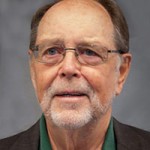
 “Rules are rules, plain and simple,” we tell our children. But that’s not always true. Government rule-making is public and procedural, not often plain and simple.
“Rules are rules, plain and simple,” we tell our children. But that’s not always true. Government rule-making is public and procedural, not often plain and simple.
Forty-four years ago, Congress passed the Employees Retirement Income Security Act (ERISA), which included simple standards to protect retirement investments. It generally required brokers to have reasonable bases for believing their investment recommendations were “suitable” for investors at the time of the transaction.
The investment landscape is much different today for workers. There were no IRAs or 401(k)s in 1974, and professionals, advising employer-sponsored retirement plans, made most important retirement investment decisions. Since then, self-directed IRAs and 401(k)s arrived, and employer retirement plans have fallen from covering about 27 million U.S. households, to 15 million. Some 77 million households now make their own investment decisions, according to Investment News, a 700% increase since 1973. Yet, ERISA rules haven’t changed.
Enter the 2008 crash, heavy investment losses for millions of elderly savers and calls for regulatory reform from President Obama and other elected types. In 2010 the U.S. Department of Labor (DOL) responded with a lengthy proposal for public comment and hearings, kicking off their formal rule-making process. Judging from subsequent reports and events, it hasn’t gone smoothly.
Among other things, DOL’s proposal called for increasing ERISA’s “suitability” standard to a “fiduciary” responsibility for nearly anyone who provides investment advice while working with retirement accounts. The difference is that a fiduciary must act in the best interests of the other party, not just ensure suitability. DOL’s schedule called for full compliance with the new rule by January 2018. With portions to be phased in earlier.
DOL compromised early, changing the first draft after receiving comments over four days of public hearings. Certain forms of compensation were allowed advisors that are usually prohibited fiduciaries, lists of assets qualifying for exemptions were broadened, and a clause allowing additional compensation for previously acquired assets was grandfathered in. Some communications were determined not to be covered “investment advice,” including general education and marketing materials, and DOL limited fees to “reasonable compensation.”
And then things got complicated. Not everyone appreciated DOL’s underlying premises. With a few notable exceptions, the lesser suitability requirement was more attractive to brokerage firms than the more severe fiduciary requirement.
In February 2017, newly inaugurated President Trump ordered an economic and legal analysis of the DOL rule and suggested a six-month delay. A month later DOL suggested a 60-day delay, stating, “It would be inappropriate to broadly delay application of the fiduciary definition and Impartial Conduct Standards for an extended period in disregard of its previous findings of ongoing injury to retirement investors.”
In late March 2017, Vanguard and Blackrock, probably the world’s two largest asset managers, called for a longer delay, and DOL opened a public comment period on whether to allow another 30 days. During the 15-day public comment period on the proposed delay, DOL reportedly received 178,000 letters in opposition out of 193,000 letters received, but ultimately announced a 60-day delay. In August 2017, DOL filed court documents as part of a lawsuit in Minnesota, according to reports, proposing an 18-month delay. That would have changed the deadline for compliance from January 1, 2018 to July 1, 2019.
On May 18, 2018, the U.S. Securities and Exchange Commission (SEC) proposed its own conflict of interest revisions, that didn’t include DOL’s stricter fiduciary requirements. SEC’s separate 90-day comment period is underway.
And the courts stepped in. The U.S. Chamber of Commerce and the Securities Industry and Financial Markets Association (a trade group and Political Action Committee) filed suit. After twice rejecting attempts by AARP and three states to intervene, the Court of Appeals in New Orleans vacated the DOL rule on March 16, 2018, in a 2-to-1 ruling that it constituted “unreasonableness,” and “an arbitrary and capricious exercise of administrative power.”
What now? DOL had defended their rule in court despite President Trump’s executive order to delay, and an appeal to the Supreme Court could have followed before a June 13 deadline. . .but wasn’t.
Federal laws don’t supersede state laws in this area, according to legal experts. States, including California, have reportedly passed or are considering legislation, and some state courts have required fiduciary standards while others found no fiduciary duty between brokers and clients. The industry, of course, would prefer a unified national rule.
Americans for Financial Reform (a collection of consumers, labor and special interest groups) claim conflicted advice costs Americans almost $17 billion annually, stating that, “A retiree who received conflicted advice when rolling over his or her 401(k) to an IRA will run out of savings five years earlier than someone who did not receive conflicted advice.”
Looks like the momentum has passed to the SEC. Will President Trump’s SEC do better? ◾
Free Seminar with SDCCU Investment Services:
Saving and Preparing for Long-Term Care

Please join us for this FREE educational seminar. Topics include:
- What is Long-Term Care?
- Realities of Long-Term Care
- Cost of Long-Term Care
Date: Wednesday, September 19
Time: 10:00 a.m. – 11:00 a.m.
Location: San Diego Workforce Partnership office
3910 University Avenue, San Diego, CA 92105
Julie Benedict Room on the 3rd Floor
Presenter: Heather Gappy, CLTC, Regional Sales Director, OneAmerica®. As Regional Sales Director for OneAmerica, Heather works with advisors and agents associated with large national broker dealers and wirehouses to discuss long-term care solutions. She provides training through group meetings and one-on-one Financial Advisor discussions. Heather worked as a commercial insurance broker and a Financial Advisor for several years before joining the Care Solutions team in 2007. she holds a Bachelor of Science in Business Administration—Emphasis in Finance from San Diego State University.
RSVP requested but not required. Visit https://www.resdc.net/events/ or call (619) 688-9229 to register. ◾
Pension Facts
Measuring Retirement Income Adequacy
CBO Says 70% of Pre-Retirement Income is Only One Metric
Pension Facts at a Glance
33%
Percentage of CalPERS retirees who do not receive Social Security (as of June 30, 2016)
By Chris Heiserman, Director
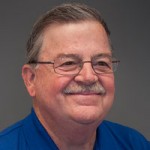 With Baby Boomer generation retirements ramping up, the share of the nation’s population 65 and over will increase from about 15% to nearly 22% over the next 30 years, according to the Congressional Budget Office (CBO). These statistics should be reinforcing concerns about whether American families will have adequate income in retirement years. In an October 2017 report, CBO explained approaches used by researchers to define what an “adequate retirement income” might mean to individuals or households in different circumstances.
With Baby Boomer generation retirements ramping up, the share of the nation’s population 65 and over will increase from about 15% to nearly 22% over the next 30 years, according to the Congressional Budget Office (CBO). These statistics should be reinforcing concerns about whether American families will have adequate income in retirement years. In an October 2017 report, CBO explained approaches used by researchers to define what an “adequate retirement income” might mean to individuals or households in different circumstances.
This is a serious national issue that is not getting nearly the attention it deserves from our elected leaders. Fortunately, it is not as critical for those of us in traditional defined benefit pension systems that pretty much guarantee a reasonable and stable retirement; however, we face the prospect of living in a world where many of our fellow citizens have no retirement plan, minimal savings and will have to rely heavily on whatever Social Security benefits they may be eligible for. This a recipe for future economic strife and growing public assistance rolls.
Frankly, most California public workers approaching the end of their government careers find themselves performing pretty basic calculations on retirement benefits to decide the best personal retirement date that suits the future lifestyle they envision. They will know the amount of their monthly pension check, and they will likely have the good fortune of weighing options for drawing periodic distributions from a tax-deferred savings account they contributed to while working. Most of these soon-to-be retirees will also be contemplating when they want to begin receiving a monthly Social Security check to supplement their retirement income.
But the situation for most private sector retirees and many other Americans approaching retirement is not as simple. The U.S. Social Security Administration currently pays benefits to about 62.3 million Americans, and nearly 43 million are retirees. Of these retired workers 62% are dependent on Social Security for at least half their income, while about a third of them rely on the program for 90% or more of their income. The average retiree on Social Security is reportedly taking home around $1,400 a month.
This is certainly a long way from a comfortable retirement, which brings us back to what the CBO report says about retirement income adequacy. It says researchers approach the topic in two ways: whether retirement income is sufficient to satisfy basic needs, or whether it allows retirees to maintain their pre-retirement standard of living.
The CBO report is labeled a “primer” on the subject of measuring retiree income adequacy because it summarizes various approaches to analyzing the issue and provides a framework for defining terms and comparing the findings of researchers. In general, studies have concluded that fewer than 10% of retirees will have income below the poverty threshold (the lowest basic needs level), while a significantly larger percentage are projected to come up short of the income needed to maintain their standard of living in retirement.
When looking at whether retirees can afford essential living expenses, then something as low as the recognized federal poverty level threshold could be considered “adequate.” On the other hand, using the more prevalent yardstick of maintaining the standard of living in retirement could also be problematic since low-income workers could already be experiencing a standard of living close to the poverty level.
The most widely used measurement of the adequacy of retirement income is based on the standard of living concept. It is called the “target replacement rate” and is expressed as a percentage of before retirement income enabling a retiree to avoid a significant decline in the lifestyle he/she had while working. A common rule of thumb for this measure is often pegged at 70% of gross pre-retirement income; however, researchers have created more specific measures which factor in individual characteristics, such as marital status and homeownership.
It makes sense to most people that their income needs in retirement will be lower than when they were working. The CBO report lists some of the reasons for this, including that retirees will generally pay less in income taxes, not be setting aside savings for retirement, have lower housing costs (if their mortgage is paid off), and will no longer have work-related expenses (clothing, transportation, dining out). When they no longer earn wages in the work force, they will avoid having Social Security tax deductions. In addition, CBO reported that about half of all Social Security beneficiaries owe no income tax on their benefits.
On the other hand, other elements can increase the amount of retirement income needed – such as higher health care costs as people get older, or long-term care expenses.
There are three measures of adequacy intended to grasp how well retirees will be able to cover the most crucial living expenses. The official federal poverty threshold provides the lowest level of adequacy for retirement income. It is set at the cost of minimum food diet in 1963 multiplied by three to account for other necessary expenses and adjusted for the change in prices. In 2015, the poverty threshold for a single person 65 or over was $11,367; the threshold for a two-person household was $14,326.
The supplementary poverty measure (SPM) threshold represents the amount spent on basic goods, including food, clothing, shelter and utilities, and a small additional amount for other basic needs. SPM thresholds are calculated for homeowners with a mortgage, homeowners without a mortgage, and renters.
The Elder Index reflects the necessary living costs faced by households that include one or two adults 65 or over living independently.
Unfortunately, the CBO report is just a starting point for a basic understanding of how researchers address the complicated analytical issues involved in evaluating whether retirement income for a wide range of people and families is considered “adequate.” Various adequacy levels can be ranked according to the income amount, from meeting basic needs to completely maintaining the pre-retirement living standard. The report describes an example of the range of possible income thresholds for a single retiree who had annual pre-retirement earnings of $60,000. Using the 70% measure would amount to $42,000, compared to the highest level of meeting basic needs (Elder Index) of about $25,000, followed by the much lower Supplemental Poverty threshold and the Official Poverty threshold.
This report does not reveal any special truths or universal guidance on the question of how much retirement income is enough. It does provide plenty of detailed information about extensive research, comparative studies and contrasting findings about the topic. If brainy government reports with lots of footnotes are your cup of tea, you can check out the full “primer” for yourself at the link below:
https://www.cbo.gov/system/files?file=115th-congress-2017-2018/reports/53191-retirementadequacy.pdf ◾
Share Your Experiences
 What has been your favorite travel adventure in retirement?
What has been your favorite travel adventure in retirement?- Why did you decide to work for San Diego County?
Please answer one of the questions above briefly (a few paragraphs) and send your comments to us by August 31st. Some of the responses may be printed in the October NETWORK. A .jpg or photo of yourself is encouraged but not required.
Emails and .jpgs maybe be sent to resdc@resdc.net. Hard copies and photos can be mailed to RESDC, 8825 Aero Dr., Suite 205, San Diego, CA 92123. Please include your name, email address, year of retirement, and department retired from. ◾
Save the Date!
2018 Coming Home Event
Thursday, October 4th, 2018 at 11:00 a.m.
Location: County Operations Center New Crime Lab (Building #5590)
5520 Overland Ave., San Diego, 92123.
Watch for more details in the September & October NETWORKS. ◾
 Bits and Pieces
Bits and Pieces
Teresa Sheehey retired from San Diego County Library in 2008. She was the branch librarian at the Fallbrook Library. She is also a retiree from Los Angeles County. About 25 years ago, Teresa adopted a baby girl from Mexico. In 2014 they discovered her adopted daughter had a younger brother and sister who were adopted by a family in Colorado. They met each other in California four years ago and keep in contact through email and Facebook. In 2017, they found several other older siblings still living in Mexico. Teresa’s daughter served four years in the Marine Corps and graduated from SDSU in 2017 with a degree in Kinesiology.
Eloise Sourk will celebrate her 102nd birthday in September. She retired from Probation in 1973. Eloise still lives in her home of forty years with her cat, Tigre.
Allan Mandell celebrated his 80th birthday in May with family and friends in Pepper Pike, OH, Vancouver, WA, and Nashville, TN where he now lives with his wife, Judith, and their cockapoo, Tevye. Allan retired in 2000 as the Director of the San Diego County Pharmacy.
Gary von Tungeln was a former Deputy Sheriff and retired in 2002 as District Attorney Investigator. He and his wife, Diane, recently celebrated their 50th wedding anniversary by taking a Viking Cruise down the Rhine River followed by a week in the Black Forest with friends from Zell, Germany.
Kathryn Grant retired in 2011 after 31 years at Health and Human Services as the LPS Public Conservator. She and her husband are about to head off for their eighth international trip since retiring. They will travel to France, Netherlands, Belgium, Germany, Luxemburg, and Switzerland including two weeks on the Rhine and Moselle Rivers. They will have visited about 35 different countries after this next trip. They love learning about other countries’ history and cultures. Kathryn also enjoys studying French and Spanish. ◾
Recent Events
- Survey: U.S. Workers Rank Retirement Security First (Prudential Financial Inc.)
Prudential Financial Inc. has survey results showing that U.S. workers care even more about retirement security than about many other hot-button public policy issues. Prudential included retirement security on a list of six economic concerns that might come up this summer as candidates are campaigning for Congress:- 80% said they want to hear more from congressional candidates about retirement security.
- Job security came in second, with 75% of the survey participants wanting to hear more about that issue.
- 67% want to hear more from candidates about the minimum wage.
- 61% want to hear more about the cost of college.
- The survey participant sample included 2,045 part-time and full-time employed adults, ages 18 and older.
- County Board of Supervisors – November Ballot Measure
At their June 26th Board of Supervisors meeting, the board unanimously approved Vice-Chairwoman Dianne Jacob’s recommendation directing the Chief Administrative Officer to return to the Board within 30 days with a charter amending ballot measure for the November 2018 election. Titled “Protecting Good Government Practices” it would include the following: Pension Stabilization – Once the Board of Supervisors has appropriated funds for pension stabilization, these funds shall not be used for any purpose other than pension-related liabilities. Long-Term Debt – proceeds from any long-term obligation of the General Fund of the County shall not be used to finance current operations or for recurring needs. ◾
Board of Supervisors Recognizes 2018 RESDC Scholarship Recipients
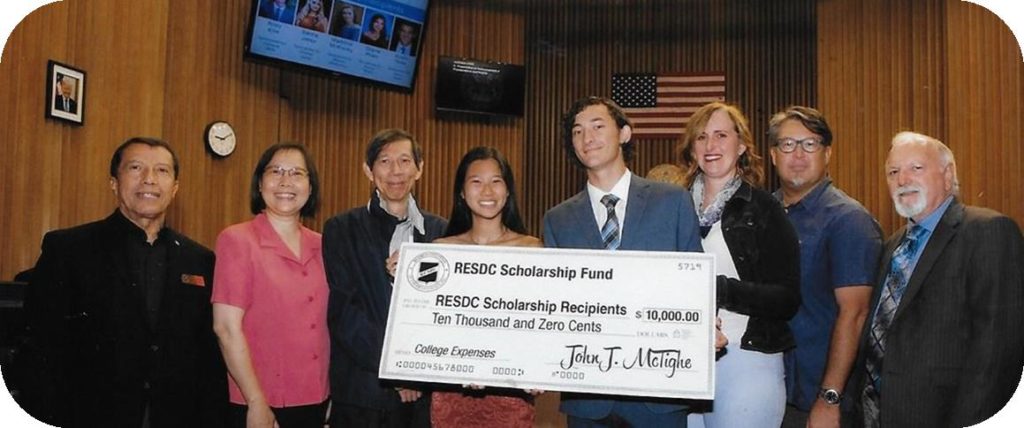
On June 19th, the Board of Supervisors recognized the 2018 RESDC Scholarship recipients along with their sponsors. Dayna Pham and Riley Ellis, two of our 2018 scholars, were in attendance. Also at the meeting were RESDC Scholarship Chairman Carlos Gonzalez and RESDC President John McTighe. Congratulations to all of the 2018 RESDC Scholarship recipients! ◾
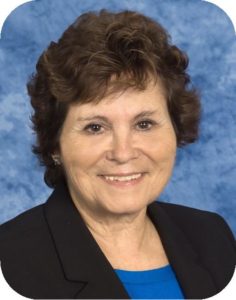 RESDC Past President Susan Mallett
RESDC Past President Susan Mallett
Elected to California Senior Legislature
We are excited to announce that former RESDC President, Susan Mallett, was recently elected to the California Senior Legislature (CSL). The CSL is a volunteer body whose primary mission is to gather ideas for legislation at the state and federal levels, craft the ideas into formal proposals, prioritize the proposals, present them to members of the Legislature or the Congress, and advocate for laws implementing the ideas. Members of the CSL are elected for four-year terms in the 33 Planning and Service Areas (PSAs) of California. When asked about her election, Mallett stated “I think it will be a good experience and give me exposure to lots of information that will interest RESDC members.” Congratulations Susan! ◾
 Save the Date!
Save the Date!
North County RESDC Roundup
September 26, 2018
Our first two Roundups were very successful. We hope you’ll join us for our next get together.
The Roundup provides an opportunity to catch up over libations and appetizers with RESDC leadership and fellow members. No reservation required (no host bar). Come meet with old friends and make some new ones!
Date: Wednesday, September 26, 2018
Time and Location to be announced in the September NETWORK. ◾
2019 SDCERA Health Plan Rates Approved
Retiree health insurance rates for 2019 were approved by the SDCERA Board of Retirement on June 21, 2018. Rates for Medicare Advantage coverage, which is utilized by about 80% of the 5,881 retirees with SDCERA health plans, will remain virtually unchanged. Modest increases were okayed for Medicare Supplement plans. Two plans for members not yet eligible for Medicare sustained higher rate increases, but Kaiser’s non-Medicare rate will not change.
Medicare Advantage
| 2018 Rate | 2019 Rate | % Increase | |
| Health Net | $286.48 | $286.48 | 0% |
| Kaiser | $270.30 | $274.10 | 1.41% |
| UHC HMO | $282.26 | $276.61 | -2% |
Medicare Supplement
| 2018 Rate | 2019 Rate | % Increase | |
| Health Net | $610.99 | $630.00 | 3.11% |
| UHC HMO | $504.93 | $519.43 | 2.87% |
Non-Medicare
| 2018 Rate | 2019 Rate | % Increase | |
| Health Net | $1,510.19 | $1,682.65 | 11.42% |
| Kaiser | $859.07 | $859.07 | 0% |
| UHC HMO | $2,334.18 | $3,034.42 | 30% |
This is a link to SDCERA’s Board Agenda memorandum on the subject:
http://sdcera.granicus.com/MetaViewer.php?view_id=2&clip_id=735&meta_id=80504
For more information about 2019 SDCERA health plan rates please contact SDCERA at (619) 515-6800. ◾
This article was submitted by My Senior Health Plan (MSHP). MSHP is a free service that works with Medicare-eligible individuals to make sure they aren’t paying too much for health insurance premiums. Call 1 (800) 243-0260 or visit www.myseniorhealthplan.com/crcea to see how much you could save on your premiums!
Do a Senior’s Nutritional Needs Change with Age?
 A senior’s nutritional needs are different from those of a young adult in their twenties – it’s a fact. As your body changes with age, you must begin to prioritize healthy eating even more than before.
A senior’s nutritional needs are different from those of a young adult in their twenties – it’s a fact. As your body changes with age, you must begin to prioritize healthy eating even more than before.
Based on your gender, height, weight and activity level, you may need less calories, but every senior requires the same, if not more nutrients. How should you change your diet to make sure you’re feeding your body what it needs?
Health Challenges Seniors May Face
A range of reasons could affect your enjoyment of foods and your desire to eat. Age brings diminished taste. You may not be as physically active and your metabolic rate slows. You could have dentures that make it impossible for you to eat certain foods.
Part of the reason a senior’s nutritional needs change is because many aging adults are dealing with health complications they didn’t use to face. If you’re taking medication for a health condition, it could cause side effects like decreased appetite. If you struggle with depression or you’ve faced an emotional trauma like the loss of a loved one, you may not want to eat at all or may only want to eat certain types of food that may not be the best choice for your overall health.
Why Worry About Your Nutrition?
From normal aging changes to complex health conditions, a senior’s nutritional needs are harder to meet, but still just as important, if not more so. Seniors are at a higher risk of heart disease, stroke, high blood pressure, diabetes and more. Good nutrition may be the central way aging adults can avoid these conditions and continue enjoying good health throughout retirement. While it may take extra time and a serious commitment, the payoff could include many additional healthy years of life.
Design a Healthy Diet
When you begin to eat less, it’s even more important that you make sure what you eat has a high nutritional value. It all starts with designing a healthy diet. Here are the food items you should be eating:
- Fruit: eat a variety of different fruits in all shapes and colors. If you have trouble chewing, you can eat canned fruit, as long as it doesn’t have any added sugar or preservatives.
- Vegetables: leafy-green vegetables like kale and spinach have antioxidants your body needs to fight off disease. Blend fruits and veggies in a smoothie to boost your daily consumption.
- Whole Grains: at least half of the grains you eat should be whole grains such as whole wheat bread or whole wheat pasta.
- Lean Meats and Seafood: salmon, chicken and grass-fed beef are great options for your daily servings.
- Dairy: dairy products like yogurt, milk and cheese provide the calcium you need, but try to choose low-fat or fat-free options.
Important Vitamins You Need
Some of the ways a senior’s nutritional needs change includes how vitamins are absorbed. Due to a decrease in stomach acid, it’s harder for seniors to break down vitamin B12 from food. Also, it’s harder for an older adult’s body to absorb the vitamin D from sun exposure. Not enough vitamin D means calcium absorption will be less efficient.
Even if you eat less calories as an older adult, you still need the same amount of nutrients, especially these three, because they preserve strong bones. Talk to your doctor and consider adding supplements if recommended. ◾
Welcome New Members
Larry A. Davis – District Attorney
Patricia M. Nemcek – Health & Human Services
Ellen Schmeding – Health & Human Services
Warren E. Smith – Superior Court
The surviving Spouse of a member is eligible for RESDC membership. For enrollment assistance, please call: (866) 688-9229. ◾
NETWORK is the official monthly newsletter of the Retired Employees of San Diego County, Inc. (RESDC), a private non-profit organization.
The information printed in the NETWORK is believed to be from reliable sources. However, no responsibility is assumed by the NETWORK for inaccuracies contained herein.
Business and Inquiries: Business matters and address changes may be recorded on our voicemail at any time, call (866) 688-9229. Please spell your name so the correct member record can be located.
Retired Employees of San Diego County, Inc.
8825 Aero Drive, Suite 205 | San Diego, CA 92123
Office Hours: 9 a.m. to 2 p.m. Monday through Friday
TELEPHONE: (866) 688-9229 Toll Free
FAX: (619) 688-0766
E-MAIL: resdc@resdc.net

